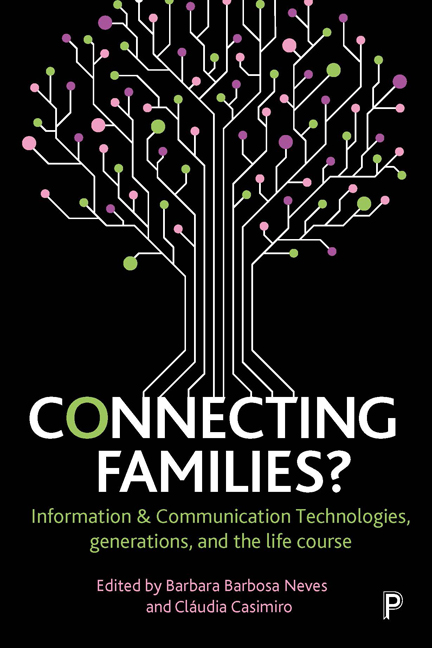Book contents
one - Connecting families? An introduction
Published online by Cambridge University Press: 22 April 2022
Summary
Context
This edited collection seeks to critically examine the intersection of family life and the use of information and communication technologies (ICTs) within generations and in a life course perspective. Over the past two decades, ICTs such as the internet and personal mobile computing have started to permeate everyday family life in industrialized countries (Eurostat, 2017; Hughes and Hans, 2001; Pew Research Center, 2017; Rainie and Wellman, 2012). Yet we still lack a thorough understanding of the interplay of ICTs and family dynamics in different regions and contexts. To address this gap, we invited researchers examining this interplay to submit their work to two sessions at conferences of the International Sociological Association (ISA). These sessions were organized for the ISA Family Research Committee (RC06), the last of which was held at the 2016 ISA Forum in Vienna. The outstanding number and quality of submissions highlighted the increasing relevance of this topic for sociologists. Our sessions aimed to address the following questions:
• Are ICTs connecting families?
• What does this connectedness mean in terms of family routines, relationships, norms, work, intimacy, and privacy?
• How do family members envision the role of ICTs in connecting families?
This book emerged from these questions, and from new angles identified in the conference sessions. Despite the growing interest in the subject (Kennedy and Wellman, 2007), as well as influential sociological work on families and domestic technologies (Cowan, 1983; Silva, 2010; Wajcman, 2010), current sociological research on ICTs and families remains scant and scattered.
There are, of course, a few notable exceptions. The seminal issue of Marriage & Family Review by Marvin B. Sussman in 1985 on ‘Personal Computers and the Family’ – also published as a book by Haworth Press in 1985 – presented groundbreaking articles on computer use within families, its implications for children's development and family life, and its role in family therapy, counselling, and empowerment. In the introduction to the book, Sussman considers changes occurring in professional environments and occupational systems as a consequence of the introduction of computers to reflect upon ‘microcomputers’ (home computers) and families. He also enquires about the relationship between social stratification and technology, and explores the use of personal computing to diagnose and treat patients in areas such as marriage and sex.
- Type
- Chapter
- Information
- Connecting Families?Information and Communication Technologies, Generations, and the Life Course, pp. 1 - 18Publisher: Bristol University PressPrint publication year: 2018

